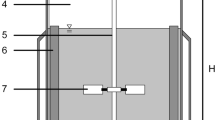Abstract
The mechanical characteristics of a new type of ejector are presented and discussed in view of its application as an aeration device for bioreactors. The experiments performed with two geometrically similar sizes allowed to do a systematic scale comparison setting forth the main scale-up criteria. Excellent performances are revealed from the investigation of pressure drops and gas entrainment rates. A perfect consistency of the two scales is obtained, even in case of gas entrainment. Using a reference velocity, empirical relationships are deduced allowing to predict the performances for any size of ejector. The dependence of the gas entrainment capacity on the backpressure is shown to be ruled out by the extremely low values of the specific aspiration energy of the ejector, and the use of a pressurized gas is only of interest in case of high backpressures. Experimental evidence is provided for the intensity of contact between the gas and liquid phases inside the ejector.
Similar content being viewed by others
Abbreviations
- D Lmm:
-
internal reference diameter of hydroejector
- D Nmm:
-
output nozzle diameter of hydroejector
- P APa:
-
ambient atmospheric pressure
- E GW m−3s:
-
specific entrainment power
- P CPa:
-
pressure in vena contracta section inside the hydro-ejector
- P GPa:
-
gas pressure
- P 0 Pa:
-
pressure downstream the hydroejector output nozzle
- P SPa:
-
supplied liquid pressure
- Q Gm3 h−1 :
-
entrained gas flow rate
- Q Lm3 h−1 :
-
liquid flow rate
- S Gm2 :
-
hydroejector gas inlet sectional area
- S Lm2 :
-
hydroejector throat area
- U GRm s−1 :
-
gas reference velocity
- U Lm s−1 :
-
liquid reference velocity
- U LCm s−1 :
-
critical liquid reference velocity for gas entrainment
- W HW:
-
hydraulic power
- z m:
-
immersion depth of hydroejector
- DOT:
-
dissolved oxygen tension
- HE:
-
hydro-ejector
- β :
-
gas-to-liquid entrainment ratio
- ρ kgm−3 :
-
liquid density
- c:
-
in the vena contracta section
- 0:
-
in the first section subsequent to vena contracta
- 0:
-
in the output section
References
Tojo K., Miyanami K.: Oxygen transfer in jet mixers. Chem. Eng. J. 24 (1982) 89–97
Jackson M., Jackson L.: Aeration in Bernouli types of devices. AIChE J. 10 (1964), 6, 836–842
Witte J. H.: Mixing shocks in two-phase flow. J. Fluid Mech. 36 (1968), 4, 639–655
Jackson M., Jackson L., Collins W., Collins D.: Scale-up of a Venturi aerator. Ind. Eng. Chem. Process Des. Dev. 3 (1964), 4, 386–393
Rainer B.W., Fonade C.: Aération des bioréacteurs par Hydro-éjecteurs. In: Récents Progrés en Génie des Procédés, vol. 3, 8b, pp. 601–606. Paris: Lavoisier 1989
Zahradnik J., Kratochvil J., Kastanek F., Rylek M.: Energy effectiveness of bubble-column reactors with sieve-tray and ejector-type gas distributors. Chem. Eng. Commun. 15 (1982) 27–40
Otake T., Tone S., Takahashi Y., Nakao K.: Dispersion of a gas in a liquid-jet ejector. Int. Chem. Engng. 21 (1981), 1, 72–80
Author information
Authors and Affiliations
Additional information
The authors are grateful to Eridania — Beghin Say for support in the achievement of the experiments at industrial scale.
Rights and permissions
About this article
Cite this article
Rainer, B., Fonade, C. & Moser, A. Hydrodynamics of a new type of ejector. Bioprocess Engineering 13, 97–103 (1995). https://doi.org/10.1007/BF00420435
Received:
Issue Date:
DOI: https://doi.org/10.1007/BF00420435




